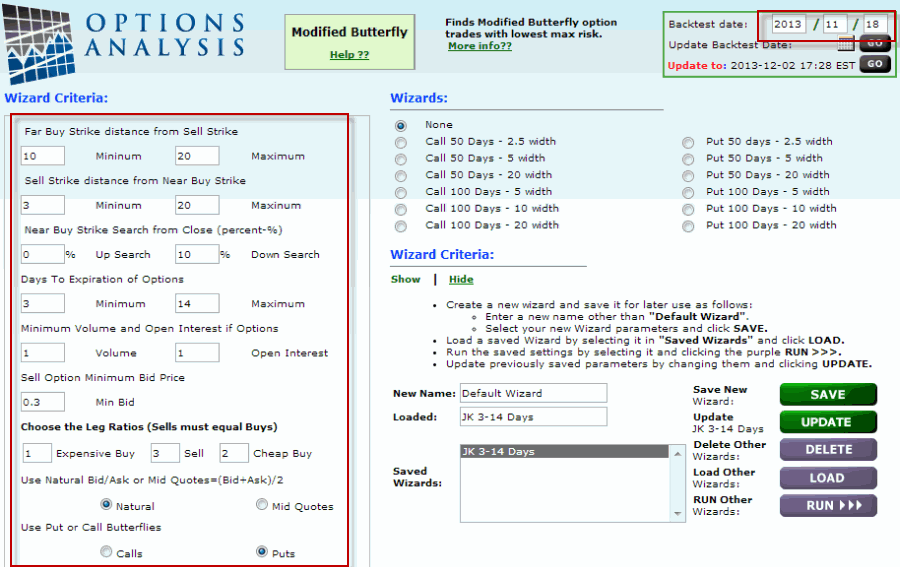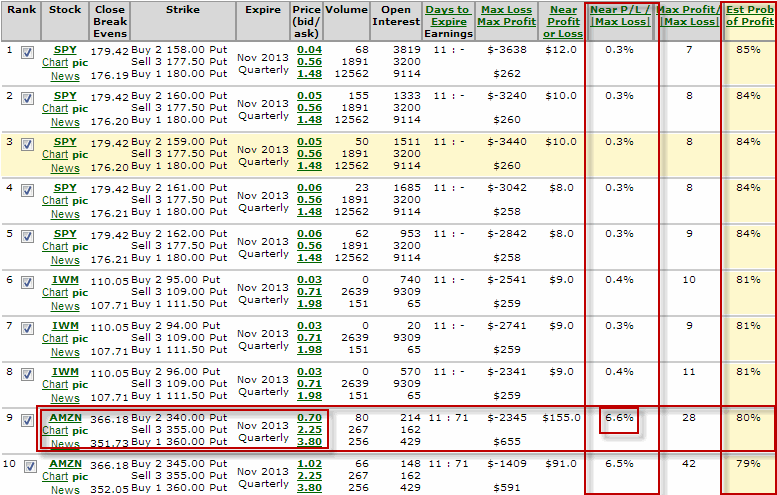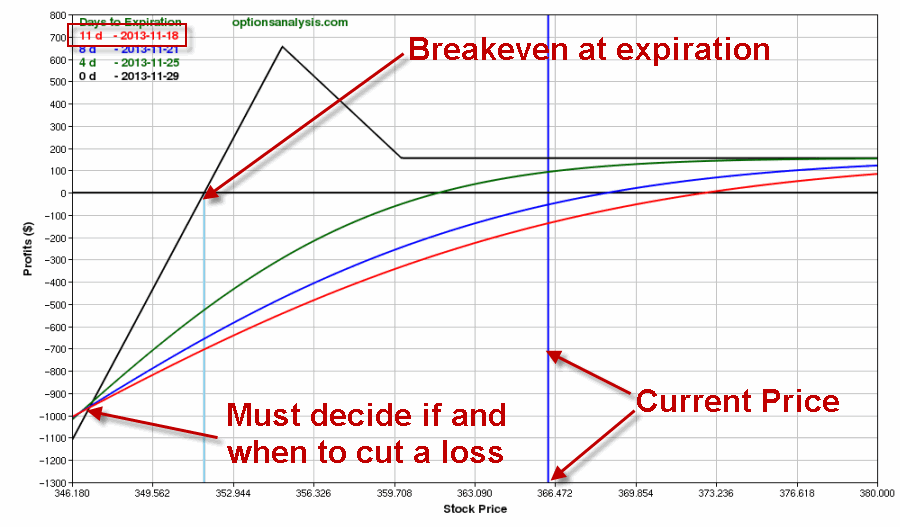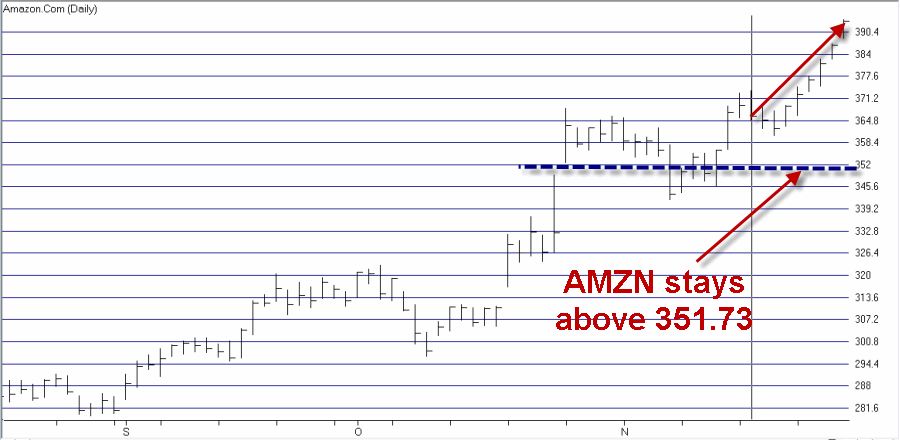Today I want to highlight an option trading strategy that relatively few traders ever consider. This strategy is known as the “Modified Butterfly”. Since I am not entirely sure who coined that phrase I will give credit to John Broussard, the developer of www.OptionsAnalysis.com, the software I use for my own options, well, analysis.
(Please view my free “Finding Exceptional Opportunities” webinar at http://go.mta.org/watch112013)
The “classic” butterfly spread involves buying one in-the-money call (or put) option, selling two at-the-money call (or put) options and buying one more out-of-the-money call (or put) option. An example of a “classic” butterfly spread appears in Figure 1, and the basic idea is to be able to make money of the underlying security remains within a particular price range.  Figure 1 – The “Classic” Butterfly Spread (Courtesy: www.OptionsAnalysis.com)
Figure 1 – The “Classic” Butterfly Spread (Courtesy: www.OptionsAnalysis.com)
The problem with the “classic” butterfly is twofold:
1) If the underlying security makes a meaningful move in either direction you are out of luck. For the record, I have found it just as difficult to predict when something “is not going to move” as it is to predict when something “is going to move.” (In fact, early in my career, whenever I would put on a “neutral” strategy such as a butterfly spread or a calendar spread, it would invariably act as some sort of cattle prod to the underlying stock itself, and the quietest, sleepiest, most boring stock in the world would suddenly burst from the gate like a bat out of you know where).
2) Logistically you can run into the “inconvenience” of finding yourself long one in the money option, short two in the money options and long one out of the money option on expiration day. If you hold this position through the close of option expiration day you end up on the following Monday with a position of short 100 shares of stock. Surprise! And not the pleasant kind for the unsuspecting.
The Modified Butterfly is essentially an attempt to put the odds slightly in your favor and to collect some option premium.
The Modified Butterfly (heretofore MB)
For the record, when the S&P 500 Index is above its 200-day moving average I prefer to look for MB’s using put options and when the S&P 500 Index is below its 200-day moving average I prefer to look for MB’s using call options.
Figure 2 displays an inputs screen from www.OptionsAnalysis.com for Modified Butterfly spreads on 11/4/13. In a nutshell, we are:
-Buying 1 out-of-the-money put option
-Selling 3 puts at a lower strike price
-Buying 2 more puts at an even lower strike price
The ultimate goal of the trade we will find is for the stock to do anything expect decline sharply (i.e., rally, stay relatively unchanged, or drop only a little) and to keep the premium we collected when the trade was entered.  Figure 2 – Modified Butterfly Inputs (Courtesy: www.OptionsAnalysis.com)
Figure 2 – Modified Butterfly Inputs (Courtesy: www.OptionsAnalysis.com)
Figure 3 displays the output. This list is sorted by % Probability of profit.  Figure 3 – Modified Butterfly Output Screen (Courtesy: www.OptionsAnalysis.com)
Figure 3 – Modified Butterfly Output Screen (Courtesy: www.OptionsAnalysis.com)
On the far right hand side you can see that a trade using SPY options has an 85% probability of profit. However, two columns over to the left we see that the credit taken in on this trade is only 0.3%. In a nutshell, we are risking $3,638 in order to make a profit of $12. In my book, this is not enough profit potential to justify taking the risk.
Ideally, I want to see:
-Probability of Profit >= 75%
-Near P/L / Maximum Risk >= 5%
-Days to option expiration <=14
-No earnings announcement due prior to option expiration
In sum, I prefer to look for the opportunity to make at least 5% in 14 days or less with at least a 75% probability of profit and no impending earnings announcement that could upend the stock.
Further down in Figure 3 we find a trade using put options on AMZN that meets these criteria. This trade risks $2,345 and takes in a credit of $155. This represents a 6.6% potential return in just 11 calendar days. 
Figure 4 – AMZN Modified Butterfly (Courtesy: www.OptionsAnalysis.com)
 Figure 5 – AMZN Modified Butterfly (Courtesy: www.OptionsAnalysis.com)
Figure 5 – AMZN Modified Butterfly (Courtesy: www.OptionsAnalysis.com)
As you can see, this trade will make money as long as AMZN stays above $351.73.
A few things to note:
-The basic goal is for the stock to not plummet in which case we simply keep the credit taken in when the trade was entered.
-However, because the downside risk is greater than the profit potential this IS NOT a “set it and forget it” type of strategy. In other words, you need to think about in advance how you will react and what steps you will take if the stock starts to fall hard and the trade starts to accumulate a loss – especially if it reaches or exceeds the breakeven price.
-There is additional upside potential if the stock happens to be between the two lower strike prices at expiration.
-The biggest risk for a trade like this is “the huge gap down.” Hence the reason I want to be sure there is no earnings announcement due prior to option expiration. Likewise we are looking for a trade with no more than two weeks left until expiration so as to minimize the amount of time we are at risk.
As you can see in Figure 6, between 11/18 and 11/29 AMZN rallied sharply so all the legs of this trade expired worthless and the initial credit was kept as a profit. Figure 6 – AMZN stays above breakeven price of $351.73 (Courtesy: AIQ TradingExpert)
Figure 6 – AMZN stays above breakeven price of $351.73 (Courtesy: AIQ TradingExpert)
Summary
Traders and investors looking for an “income generating” strategy using options might do well to take a closer look at the Modified Butterfly spread. If done right and managed properly this strategy can generate a series of relatively small profits that accumulate nicely over time.
The one “real world of trading” caveat to keep in mind is this: This is one of those strategies where one unmanaged losing trade can wipe out a lot of small profits garnered along the way. So the two keys to success with this strategy are:
1) Follow the guidelines listed earlier to focus on the best opportunities
2) Develop a “fail safe” plan for each and every trade so that you are prepared when the “outlier” occurs (because eventually it will)
Jay Kaeppel

